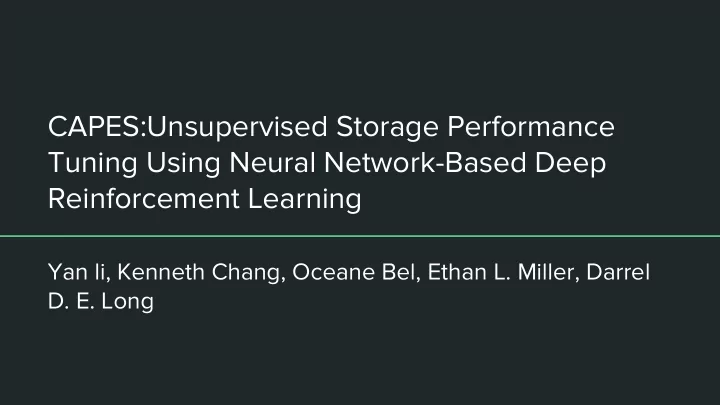

CAPES:Unsupervised Storage Performance Tuning Using Neural Network-Based Deep Reinforcement Learning Yan li, Kenneth Chang, Oceane Bel, Ethan L. Miller, Darrel D. E. Long
Performance Tuning ● Tuning system’s parameters for high performance ● Can be very challenging ○ Correlation between several variables in a system ○ Delay between action and resulting change in performance Huge search space ○ ○ Requires extensive knowledge and experience ● Static parameter values for dynamic workloads ● Congestion Curse-Exceeding certain load limit will negatively affect the performance of several components ● Automated Performance Tuning is required!!
Automated Parameter Tuning ● Challenges ○ Systems are extremely complex. Workloads are dynamic and they also affect each other ○ ○ Responsiveness ○ Scalability Has to be tuned for multiple objective functions. ○ ● Dynamic parameter tuning-Partially Observable Markov Decision Process ● Hard Problem Varying delays between action and result ○ ○ Change in performance could be a result of sequence of modifications ● Credit Assignment Problem
CAPES ● Computer Automated Performance Enhancement System ● Unsupervised Problem ○ Parameters can change based on several factors not just workload. So labelled data is impractical ● Model-less Deep Reinforcement Learning A game to find parameter values that maximize/minimize some function(may be throughput or ○ latency) ○ Use of deep learning techniques with reinforcement learning.
Q-value Return: Q-value: Policy: Bellman Equation:
Deep-Q-Learning ● Need to learn Q-function ○ Core of Q-learning ● Q-network ○ A deep neural network to approximate the Q-function Output of Q-network will be a Q-value for a given state and action ○ ○ Weights of the network to reduce the MSE for samples ● Since we don’t have the actual Q -value of all possible actions we try to approximate and over time we update the weights to predict reasonable predictions.
Architecture ● Monitoring Agent ○ Gather Information about current state of the network and rewards(objective function) Communicate with Interface daemon ○ ● Replay Database ○ Stores received information and performed actions Experience DB ○ ● DRL Engine ○ Reads the data from replay DB and sends back an action. ● Control Agents ○ Performs the received action on the nodes. ● Interface Daemon Communicates between CAPES and target system ○ ● Action Checker Checks if the action is valid ○
Algorithm ● Data is collected at certain frequency(1 sec) ○ Sampling Tick Sends only when its different from previous tick ○ ● Observation matrix to capture the trend d=objective ,i=node, j=time,N=total nodes,S=sampling ticks Batches of these observations are send to DRL engine Reduce the data movement overhead
Neural Network Training ● It is proven that a NN with 1 hidden layer can approximate any mathematical function ● 2 hidden layer network ○ Adam optimizer is used ○ Tanh activation is used ● Output layer consists of same number of nodes as the number of actions each denoting a action. ● Each training step needs the state transition information which is checked in Replay DB before training.
Performance Indicators and Rewards ● Performance Indicators-Feature extraction problem ○ Can be relaxed as DNN are known for feature extraction Date and time can be included as separate features if workloads seem to be cyclic ○ ○ Raw and secondary system status can be used ● Rewards ○ Immediate rewards are taken after an action is performed ○ Reward is objective function like latency or throughput No need to worry about delay in change of the performed action ○ ● Actions ○ Increase or decrease the value of parameter by a step size-can be varied based on system ○ Null action is also included if no action is required This makes total number of actions 2 x tunable_parameter +1 ○
Implementation ● Lustre file system-high performance distributed file system ● 1 Object Storage client/client and 4 servers and implemented using 5 clients. ● All nodes have the same system configuration ○ 113MB/s read ,106 MB/s write ○ Default stripe count of 4 with 1MB stripe size 1:1 network to storage bandwidth ratio -HPC ○ ● CAPES runs on different dedicated node ● Only 2 parameters are tuned Max_rpc_in_flight:congestion window size ○ ○ I/O rate limit:outgoing I/O requests allowed
Evaluation
Training Evaluation
Training impact on performance Random action during start of training
Thoughts: ● It would be better if CAPES/other technique on top of capes can even select/give more importance to different tunable parameters based on requests. ● There is still a possibility for improvement by using other RL methods like Actor-critic where multiple agents are trained for the same problem-each will have different experience . ● Increment or decrement of parameter by a fixed step size doesn’t seem logical.It can also be scaled based on the workload.
Recommend
More recommend